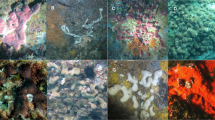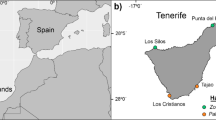Abstract
Patterns of associations between coral colonies and the major clades of zooxanthellae can vary across scales ranging from individual colonies to widely separated geographic regions. This is exemplified in this study of the Montastraea annularis species complex from six sites on the Mesoamerican Reef, Belize and nine sites in the Bocas del Toro archipelago, Panama. Restriction fragment length polymorphism (RFLP) analysis of small subunit ribosomal DNA (SSU rDNA) was used to identify the zooxanthellae. In Belize (M. annularis), Symbiodinium B (79% of the colonies), Symbiodinium A, and Symbiodinium C were observed. In Panama (primarily M. franksi, but also M. annularis and M. faveolata), there was greater diversity and evenness with Symbiodinium A, B, C, C′ (a new symbiont) and D all being common in at least some host/habitat combinations. Non-metric multidimensional scaling ordinations showed that distribution patterns of symbionts across sites are best explained by enclosure (relative influence of open ocean vs. coastal water) and total suspended solids. Because members of clade D are known to be temperature resistant and Symbiodinium C′ was found in environments characterized by high sedimentation, these Panamanian reefs may have importance from a management perspective as reservoirs of corals better able to tolerate human impacts.





Similar content being viewed by others
References
Andrefouet S, Mumby PJ, McField M, Hu C, Muller-Karger FE (2002) Revisiting coral reef connectivity. Coral Reefs 21:43–48
Anthony KRN (2000) Enhanced particle-feeding capacity of corals on turbid reefs (Great Barrier Reef, Australia). Coral Reefs 19:59–67
Aronson RB, Macintyre IG, Wapnick CM, O’Neil MW (2004) Phase shifts, alternative states, and the unprecedented convergence of two reef systems. Ecology 85:1876–1891
Baker AC (1999) The symbiosis ecology of reef-building corals. Ph.D. thesis, University of Miami, p 120
Baker AC (2003) Flexibility and specificity in coral–algal symbiosis: diversity, ecology, and biogeography of Symbiodinium. Annu Rev Ecol Syst 34:661–689
Baker AC, Starger CJ, McClanahan TR, Glynn PW (2004) Corals’ adaptive response to climate change. Nature 430:741
Bellwood DR, Hughes TP, Folke C, Nystrom M (2004) Confronting the coral reef crisis. Nature 429:827–833
Brown BE, Dunne RP, Goodson MS, Douglas AE (2002) Experience shapes the susceptibility of a reef coral to bleaching. Coral Reefs 21:1191–1226
Bryant D, Burke L, McManus J, Spalding M (1998) Reefs at risk: a map-based indicator of potential threats to the world’s coral reefs. World Resources Institute, Washington
Burke L, Maidens J (2004) Reefs at risk in the Caribbean. World Resources Institute, Washington
Carruthers TJB, Barnes PAG, Jacome GE, Fourqurean JW (2005) Lagoon scale processes in a coastally influenced Caribbean system: implications for the seagrass Thalassia testudinum. Caribb J Sci 41:441–445
Chen CA (2003) A stable association of the stress-tolerant zooxanthellae, Symbiodinium clade D, with the low-temperature-tolerant coral, Oulastrea crispata (Scleractinia: Faviidae) in subtropical non-reefal coral communities. Zool Stud 42:540–550
Chen CA, Yang Y-W, Wei NV, Tsai W-S, Fang L-S (2005) Symbiont diversity in scleractinian corals from tropical reefs and subtropical non-reef communities in Taiwan. Coral Reefs 24:11–22
Clarke AJ, Warwick RM (1994). Change in marine communities: an approach to statistical analysis and interpretation. Natural Environment Research Council, Plymouth
D’Sa EJ, Hu C, Mueller-Karger FE, Carder KL (2002) Estimation of color dissolved organic matter and salinity in case 2 waters using SeaWiFs: Examples from Florida Bay and Florida Shelf. Proc Indian Acad Sci Earth Planet Sci 111:197–207
Gardner TA, Cote IM, Gill JA, Grant A, Watkinson AR (2003) Long-term region-wide declines in Caribbean corals. Science 301:958–960
Goreau T (1959) The ecology of Jamaican coral reefs. I. Species composition and zonation. Ecology 40:67–90
Grottoli AG (2006) Heterotrophic plasticity and resilience in bleached corals. Nature 440:1186–1189
Hughes TP, Baird AH, Bellwood DR, Card M, Connolly SR, Folke C, Grosberg R, Hoegh-Guldberg O, Jackson JBC, Kleypas J, Lough JM, Marshall P, Nystrom M, Palumbi SR, Pandolfi JM, Rosen B, Roughgarden J (2003) Climate change, human impacts, and the resilience of coral reefs. Science 301:929–933
Kline D, Kuntz NM, Breitbart M, Knowlton N, Rohwer F (2006) Role of elevated organic carbon levels and microbial activity in coral mortality. Mar Ecol Prog Ser 314:119–125
Knowlton N (2001) The future of coral reefs. Proc Natl Acad Sci USA 98:5419–5425
Knowlton N, Rohwer F (2003) Multispecies microbial mutualisms on coral reefs: the host as a habitat. Am Nat 162:S51–S62
Kuntz NM, Kline DI, Sandin SA, Rohwer F (2005) Pathologies and mortality rates caused by organic carbon and nutrient stressors in three Caribbean coral species. Mar Ecol Prog Ser 294:173–180
LaJeunesse TC (2001) Investigating the biodiversity, ecology, and phylogeny of endosymbiotic dinoflagellates in the genus Symbiodinium using the ITS region: In search of a “species” level marker. J Phycol 37:387–400
LaJeunesse TC (2002) Diversity and community structure of symbiotic dinoflagellates from Caribbean coral reefs. Mar Biol 141:387–400
Loh WKW, Loi T, Carter DR, Hoegh-Guldberg O (2001) Genetic variability of the symbiotic dinoflagellates from the wide ranging coral species Seriatopora hystrix and Acropora longicyathus in the Indo-West Pacific. Mar Ecol Prog Ser 222:97–107
Marshall PS, Schuttenberg HZS (2005) Understanding patterns of bleaching in the Mesoamerican Reef: a collaborative effort to support resilience-based management. Reef Manager’s Guide to Coral Bleaching. Great Barrier Reef Marine Park Authority, Australia
McClanahan TR, Muthiga NA (1998) An ecological shift in a remote coral atoll of Belize over 25 years. Environ Conserv 25:122–130
Norberg J, Swaney DP, Dushoff J, Lin J, Casagrandi R, Levin SA (2001) Phenotypic diversity and ecosystem functioning in changing environments: a theoretical framework. Proc Natl Acad Sci USA 98:11376–11381
O’Dea A, Jackson JBC (2002) Bryozoan growth mirrors contrasting seasonal regimes across the Isthmus of Panama. Palaeogeogr Palaeoclimatol Palaeoecol 185:77–94
Pandolfi JM, Bradbury RH, Sala E, Hughes TP, Bjorndal KA, Cooke RG, McArdle D, McClenachan L, Newman MJH, Paredes G, Warner RR, Jackson JBC (2003) Global trajectories of the long-term decline of coral reef ecosystems. Science 301:955–958
Rodriguez-Lanetty M, Loh W, Carter DR, Hoegh-Guldberg O (2001) Latitudinal variability in symbont specificity within the widespread scleractinian coral Plesiastrea versipora. Mar Biol 138:1175–1181
Rowan R, Knowlton N (1995) Intraspecific diversity and ecological zonation in coral–algal symbiosis. Proc Natl Acad Sci USA 92:2850–2853
Rowan R, Powers DA (1991) A molecular genetic classification of zooxanthellae and the evolution of animal–algal symbioses. Science 251:1348–1351
Rowan R, Knowlton N, Baker A, Jara J (1997) Landscape ecology of algal symbionts creates variation in episodes of coral bleaching. Nature 388:265–269
Schoenberg DA, Trench RK (1980) Genetic variation in Symbiodinium (= Gymnodinium) microadriaticum Fruedenthal, and specificity in its symbioses with marine invertebrates. Isoenzymes and soluble protein patterns of axenic cultures of Symbiodinium microadriaticum. Proc R Soc Biol Sci Ser B 207:429–444
Toller WW, Rowan R, Knowlton N (2001a) Repopulation of zooxanthellae in the Caribbean corals Montastraea annularis and M. faveolata following experimental and disease-associated bleaching. Biol Bull 201:360–373
Toller WW, Rowan R, Knowlton N (2001b) Zooxanthellae of the Montastraea annularis species complex: patterns of distribution of four taxa of Symbiodinium on different reefs and across depths. Biol Bull 201:348–359
Weil E, Knowlton N (1994) A multi-character analysis of the Caribbean coral Montastraea annularis (Ellis and Solander, 1786) and its two sibling species, M. faveolata (Ellis and Solander, 1786) and M. franksi (Gregory, 1895). Bull Mar Sci 55:151–175
Wilkinson CR (1987) Interocean differences in size and nutrition of coral reef sponge populations. Science 236:1654–1657
Wilkinson C (2004) Status of coral reefs of the world: 2004. Global Coral Reef Monitoring Network and Australian Institute of Marine Sciences, Townsville, Australia
Acknowledgments
We thank Javier Jara, Arcadio Castillo, Todd LaJeunesse, David Call, Monique Mendez, Eyda Gomez, Hiro Fukami, John Goeltz, David Kline, Melanie McField, Eden Garcia, Brian Young, and Oliver Balmer for their assistance with various aspects of the study. We thank the WWF-Protected Area Program, Yale’s Environmental Summer Internship Program, the Smithsonian Institution and the Scripps Institution for providing financial support, and Panama’s Dirección Nacional de Patrimonio Natural and La Autoridad Administrativa de CITES of the National Authority for the Environment (ANAM) for permission to collect and export coral samples.
Author information
Authors and Affiliations
Corresponding author
Additional information
Communicated by Biology Editor M. van Oppen.
Rights and permissions
About this article
Cite this article
Garren, M., Walsh, S.M., Caccone, A. et al. Patterns of association between Symbiodinium and members of the Montastraea annularis species complex on spatial scales ranging from within colonies to between geographic regions. Coral Reefs 25, 503–512 (2006). https://doi.org/10.1007/s00338-006-0146-1
Received:
Accepted:
Published:
Issue Date:
DOI: https://doi.org/10.1007/s00338-006-0146-1




